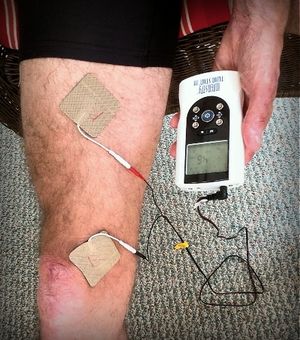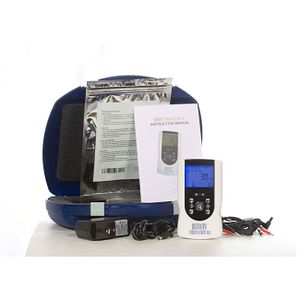Electrical Muscle Stimulation

Electrical Muscle Stimulation is the direct of stimulation a muscle using an electric current that is applied via electrode patches on the skin. EMS may be useful in the treatment of Knee Pain, preventing muscle atrophy after injury, and as an addition to regular training.
Contents
1 What EMS Can and Can't Do
Like any technology, it's important to understand what it can and can't do.
- Does not cause discomfort. EMS is generally well tolerated and does not cause discomfort[1]. (EMS units have intensity controls, and increasing the intensity too high can be painful.)
- Does Increase strength. Many studies have shown that EMS can increase strength[2][3][4][5][6]. For instance one study showed an increase in quad strength by over 20% in untrained subjects[7]. (As an aside, this study trained only one leg with EMS, and the other untrained leg gained 15% strength. This effect, where training one limb increases the strength in the other, has been known about since at least 1894 and is called the Contralateral Strength Training Effect[8]. )
- Does Increase Muscle Recruitment. Studies indicate that EMS increases muscular recruitment and that this may be the underlying mechanism for some of the strength gains[4][5][6][9].
- Does Increase Blood flow. EMS can increase the flow of blood to a muscle[10][1]. (Lower frequencies of around 7-9Hz seem to be optimal[1].)
- Does Not Reduce Weight. EMS does not help with weight reduction or fat loss[11][12]. In 2002 the FTC charged three companies with false claims about weight loss from EMS devices[13].
- Can Cause DOMS. It's not a surprise given that EMS is a form of strength training, but EMS can cause Delayed Onset Muscle Soreness[14]. (EMS may also help relieve DOMS - see below.)
- Endurance - Unclear. They are few studies on the use of EMS for endurance. A study of sedentary subjects showed a 10% increase in V̇O2max[15], but this study used an unusually large level of EMS over an unusually large area. I found no studies of endurance benefits for trained athletes. A study did show a doubling of the number of abdominal curls that could be performed after EMS training[12], but this is not "endurance" in the sense a runner would mean.
- Can Activate Deep Muscles. It was generally thought that EMS tends to activate fibers nearer to the surface[16], but MRI scans have shown that even low levels can activate deep muscles[17]. This may be because EMS is stimulating superficial nerves that control deeper muscles[16].
- Can Help with Knee Pain. Studies have shown that EMS of the VMO (part of the quad near the knee on the inside of the thigh) can help reduce Knee Pain[18]. The recommendation is for eight weeks of EMS consisting of 20 min. sessions twice a day (18 sec stimulation and 25 sec rest)[18].
- May improve muscle recovery. There is some limited evidence that EMS may help with recovery from DOMS, probably due to increased blood flow[19].
2 Why use EMS?
The main reasons to use EMS are around injury treatment and rehabilitation. EMS may be able to directly help with Knee Pain (see above), as well as reducing the loss of muscle strength (atrophy) that can occur while injured. EMS may be a beneficial supplement to regular training, but I have not found sufficient guidelines or studies that would define the optimal usage pattern.
3 EMS and TENS
EMS is similar to TENS (Transcutaneous Electrical Nerve Stimulation), and many devices, such as the one recommended below, a capable of both EMS and TENS. The difference between the two is that EMS is intended to activate muscle fibers, where TENS is used at a lower intensity with the goal of reducing pain.
4 Choosing an EMS device
EMS devices vary wildly in price, from less than $50 to over $800. All devices sold in the US must be FDA certified[11], so to avoid any device sold in the US without this certification. EMS devices for muscle stimulation can be sold in the US without a prescription, but devices to treat specific medical conditions require a doctor's prescription[11]. In looking at the specifications for a number of devices, it appears that they have generally similar capabilities:
- Max current: ~100mA
- Frequency range: 1-150Hz
- Pulse width: 50-400us
Different devices had two to eight electrodes (one to four channels), and some devices had a TENS mode for pain reduction. Some devices had preset programs for different body parts or for different effects, while others allowed you to set the specific parameters such as current, frequency, pulse width.I looked a wide variety of devices and eventually settled on the InTENSity Twin Stim III. This device provides full control of all parameters with the widest range of settings I found, comes with an AC adapter (useful as EMS devices have a reputation for eating batteries), and was available for only $50. So far I've been remarkably happy with it.
5 Replacement Pads
The sticky electrode pads are reusable and last for 5-20 uses. The sticky on the pads degrades quite slowly, so how many times you use them may depend on the location you're trying to stick them to. Flat, smooth locations like the quad are easy to stick to, where attaching them to the end of the VMO requires a little more adhesion. I ordered these replacement pads from amazon.com and they were $25 for 40 pads, so the running costs are quite low.
6 Important Cautions
Though EMS is generally safe, you should be aware of these critical restrictions[20]:
- Do not apply to the chest area if you have any heart conditions.
- If you have a pacemaker, do not use EMS anywhere on your body.
- Do not apply EMS to the Carotid sinus area of the neck, as this could affect heart rate or blood pressure.
- Do not apply through your head.
- Do not apply through cancerous tissue.
- Applying to EMS through broken or irritated skin will cause discomfort.
- Do not apply to protruding metal such as surgical staples or pins.
Other cautions:
- Be careful applying high intensity EMS directly over superficial bones, as this can be painful.
- Applying EMS over thick areas of fat may require painfully high intensity to reach the underlying muscle.
- Avoid applying EMS near the uterus if you are pregnant.
If you have any doubts or concerns contact a healthcare professional.
7 EMS and Intermittent Hypoxic Exposure
There has been little research on combining EMS and Intermittent Hypoxic Exposure (IHE), but there is a suggestion that the two may be synergistic in some way[21].
8 InTENSity Twin Stim III Settings
It's not clear how the settings for EMS change the effect. Here are the settings I use, based on a little trial and error. Don't consider these a recommendation, just some extra information.
- TENS/EMS - EMS
- Synchronous [S/A/D]
- Pulse Width 300 us (longest setting)
- Pulse Rate 7 Hz
- Ramp 6 seconds
- On Time 6 seconds
- Rest Time 6 seconds
9 References
- ↑ 1.0 1.1 1.2 Patient tolerance of neuromuscular electrical s... [Med Eng Phys. 2011] - PubMed - NCBI http://www.ncbi.nlm.nih.gov/pubmed/20926329
- ↑ Electrostimulation training effects on ... [Med Sci Sports Exerc. 2005] - PubMed - NCBI http://www.ncbi.nlm.nih.gov/pubmed/15741845
- ↑ The effects of electromyostimulation traini... [Int J Sports Med. 2000] - PubMed - NCBI http://www.ncbi.nlm.nih.gov/pubmed/10961520
- ↑ 4.0 4.1 Electromyostimulation training effects ... [Med Sci Sports Exerc. 2005] - PubMed - NCBI http://www.ncbi.nlm.nih.gov/pubmed/16118574
- ↑ 5.0 5.1 Activation of human plantar flexor muscles increases after electromyostimulation training http://jap.physiology.org/content/92/4/1383.full
- ↑ 6.0 6.1 European Journal of Applied Physiology and Occupational Physiology, Volume 67, Number 5 - SpringerLink http://www.springerlink.com/content/w42n8tn66421416r/
- ↑ Strength changes in the normal quadriceps femoris ... [Phys Ther. 1983] - PubMed - NCBI http://www.ncbi.nlm.nih.gov/pubmed/6601279
- ↑ Contralateral effects of unilateral strength training: evidence and possible mechanisms http://jap.physiology.org/content/101/5/1514.full
- ↑ Motor unit recruitment during neuromuscul... [Eur J Appl Physiol. 2011] - PubMed - NCBI http://www.ncbi.nlm.nih.gov/pubmed/21870119
- ↑ [Effect of the frequency of neuromuscular electri... [J Mal Vasc. 1995] - PubMed - NCBI http://www.ncbi.nlm.nih.gov/pubmed/7745364
- ↑ 11.0 11.1 11.2 Consumer Products > Electronic Muscle Stimulators http://www.fda.gov/MedicalDevices/ProductsandMedicalProcedures/HomeHealthandConsumer/ConsumerProducts/ucm142478.htm
- ↑ 12.0 12.1 JSSM- 2005, Vol.4, Issue 1, 66 - 75 http://www.jssm.org/vol4/n1/9/v4n1-9abst.php
- ↑ FTC Charges Three Top-selling Electronic Abdominal Exercise Belts with Making False Claims http://www.ftc.gov/opa/2002/05/projectabsurd.shtm
- ↑ Evidence of skeletal muscle damage following electrically stimulated isometric muscle contractions in humans http://jap.physiology.org/content/105/5/1620.full
- ↑ Prolonged electrical muscle stimulation exercise improves strength and aerobic capacity in healthy sedentary adults http://jap.physiology.org/content/99/6/2307.short
- ↑ 16.0 16.1 Recruitment Patterns in Human Skeletal Muscle During Electrical Stimulation http://ptjournal.apta.org/content/85/4/358.full
- ↑ Mapping of electrical muscle stimulation using MRI http://jap.physiology.org/content/74/2/532.short
- ↑ 18.0 18.1 Clinical classification of patellofemoral pain syndrome- guidelines for non-operative treatment, Erik Witvrouw, S. Werner, C. Mikkelsen, D. Van Tiggelen, L. Vanden Berghe, G. Cerulli
- ↑ IOS Press - Journal Article http://iospress.metapress.com/content/u7487q33772457g4/
- ↑ Contraindications and Precautions to Electrical Stimulation http://faculty.uca.edu/fletcher/electro/unit1_TENS/Contraindications%20&%20Precautions%20to%20E-Stim.pdf
- ↑ Combined intermittent hypoxia and surface muscle electrostimulation as a method to increase peripheral blood progenitor cell concentration http://www.translational-medicine.com/content/7/1/91/
